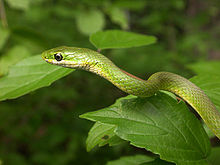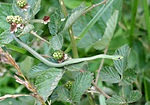- Opheodrys aestivus
-
rough green snake 
Conservation status Scientific classification Kingdom: Animalia Phylum: Chordata Subphylum: Vertebrata Class: Reptilia Order: Squamata Suborder: Serpentes Family: Colubridae Subfamily: Colubrinae Genus: Opheodrys Species: O. aestivus Binomial name Opheodrys aestivus
(Linnaeus, 1766)Synonyms The rough green snake (Opheodrys aestivus) is a nonvenomous North American colubrid. It is sometimes called grass snake or green grass snake, but these names are more commonly applied to the smooth green snake (Opheodrys vernalis). The European colubrid called grass snake (Natrix natrix) is unrelated. The rough green snake is docile, often allowing close approach by humans, and seldom bites.
Contents
Description
The snake is bright green above and has a yellowish belly, affording it excellent camouflage in green vegetation. It has keeled dorsal scales. It grows up to 116 cm (45½ inches) in total length[2] and is very thin.
Geographic range
The rough green snake ranges throughout the Southeastern United States, from Florida, north to New Jersey, and west to central Texas. The snake is commonly found in the Piedmont and Coastal Plain, but are not found in the higher elevations of the Appalachian Mountains. It is also found in northeastern Mexico, including the state of Tamaulipas and eastern Nuevo León.
Habitat
Its preferred habitat is moist meadows and woodlands, often near water. It is highly arboreal, frequently found climbing in low vegetation, and is also a good swimmer. However, it is often found on the ground as well. Unlike many snakes, it is largely diurnal.
Diet
Its diet consists mostly of insects and other terrestrial arthropods, but some snails and tree frogs are eaten as well. This snake is not a constrictor—most prey are grabbed and simply swallowed alive.
Predation
Predators of the rough green snake include birds, spiders, and other snakes, such as the Eastern racer (Coluber constrictor) and the Eastern king snake (Lampropeltis getula).
Reproduction
The rough green snake breeds in spring, and sometimes again in fall. Females lay 2-14 eggs, occasionally in a communal nest shared by more than one female. Up to 75 eggs have been found in one such nest. The nest site varies: under boards, under bark in rotting stumps, in deep mulch, or under a rock. Hatchlings from spring breeding typically emerge in August or September, and are about 7-8 inches in length.
Conservation status
The rough green snake is widespread and is not of conservation concern, in general. However urban development, especially the reduction of vegetation near waterways, may reduce their numbers. Many are killed on roads, and they may be susceptible to poisoning by pesticides used on their insect prey.
Subspecies
- Northern rough green snake, Opheodrys aestivus aestivus (Linnaeus, 1766)
- Florida rough green snake, Opheodrys aestivus carinatus Grobman, 1984
also named as Angelo
References
- Aardema et al. Amphibians and Reptiles of North Carolina--accessed 29 May 2006
- Conant et al. (1998). A Field Guide to Reptiles and Amphibians of Eastern and Central North America. Boston: Houghton Mifflin. ISBN 0-395-90452-8.
- Cook, Will. Carolina Nature--accessed 29 May 2006.
- Gibbons, Whit, Michael E. Dorcas, and J. Whitfield Gibbons (2005). Snakes Of The Southeast. Athens, Georgia: University of Georgia Press. ISBN 0-8203-2652-6.
- Martof et al. (1980). Amphibians and Reptiles of the Carolinas and Virginia. Chapel Hill: University of North Carolina Press. ISBN 0-8078-4252-4.
- Myers, P., R. Espinosa, C. S. Parr, T. Jones, G. S. Hammond, and T. A. Dewey. 2006. Animal Diversity Web. Accessed May 29, 2006.
- Palmer, William M., Alvin L. Braswell, Renaldo Kuhler (1995). Reptiles of North Carolina. Chapel Hill: University of North Carolina Press. ISBN 0-8078-2158-6.
- University of Georgia, Savannah River Ecological Laboratory, Animal Fact Sheets--accessed 1 June 2006
- University of Georgia, Savannah River Ecological Laboratory, Reptiles and Amphibians of South Carolina and Georgia--accessed 1 June 2006
Categories:- IUCN Red List least concern species
- Colubrids
- Fauna of Delaware and Maryland
- Reptiles of the United States
- Reptiles of Mexico
- Fauna of Northeastern Mexico
Wikimedia Foundation. 2010.


